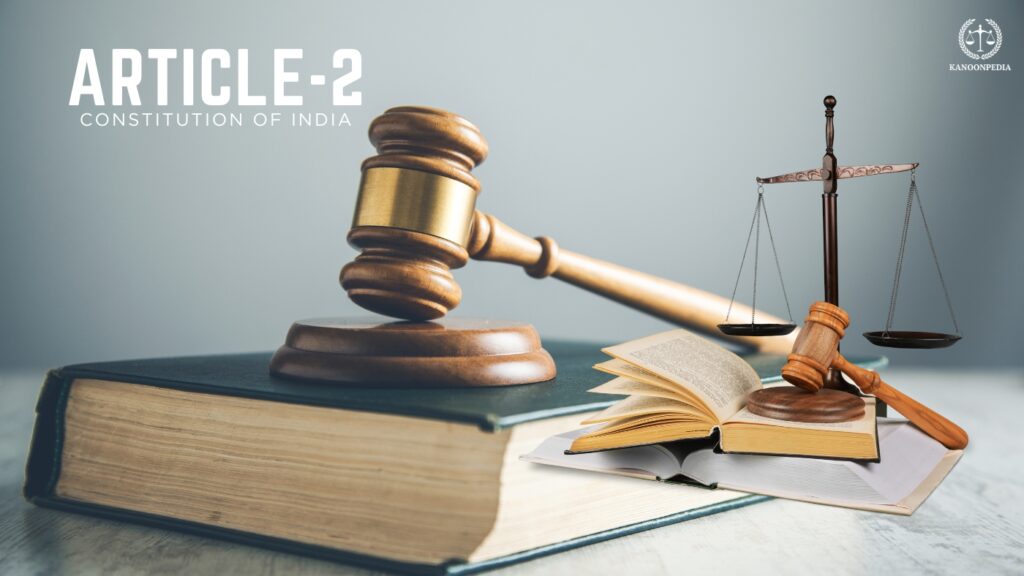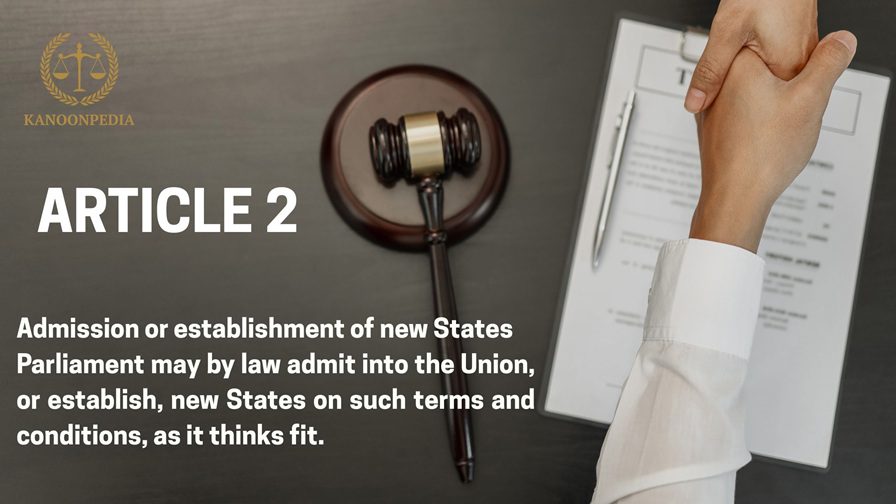Article 2 of the Indian Constitution empowers Parliament to admit or establish new states into the Union of India. This seemingly straightforward provision has profound implications for India’s federal structure and territorial evolution. This comprehensive analysis breaks down Article 2 from multiple perspectives, providing valuable insights for UPSC aspirants, judiciary candidates, law students, and legal practitioners.

Table of Contents
Article Bifurcation & Textual Analysis
Article 2 states: “Parliament may by law admit into the Union, or establish, new States on such terms and conditions as it thinks fit.”

This provision can be bifurcated into three key components:
- Parliamentary Authority: “Parliament may by law” – This establishes that only Parliament, not state legislatures or other bodies, has the authority to admit or establish new states, and this must be done through legislation.
- Dual Powers: “admit into the Union, or establish, new States” – This grants Parliament two distinct powers:
- To “admit” existing political entities into the Union
- To “establish” entirely new states where none existed before
- Discretionary Terms: “on such terms and conditions as it thinks fit” – This grants Parliament wide discretion to determine the conditions under which new states join the Union, including representation in Parliament, financial arrangements, and special provisions.
The phrase “on such terms and conditions as it thinks fit” is particularly significant as it gives Parliament considerable flexibility in determining how new states are integrated into the Indian Union. This discretionary power is broader than that granted under Article 3, which deals with reorganization of existing states.
Landmark Judicial Interpretations
R.C. Poudyal v. Union of India (1994)
Facts: This case challenged the special provisions made for Sikkim when it was admitted as a state of India, particularly the reservation of seats in the Sikkim Legislative Assembly for specific communities.
Legal Questions: Whether Parliament’s power under Article 2 to impose “terms and conditions” could include provisions that appeared to violate the principle of equality under Article 14.
Court’s Reasoning: The Supreme Court upheld the special provisions for Sikkim, ruling that Parliament’s power under Article 2 is plenary and includes the authority to make special arrangements that might not be permissible for other states under normal circumstances.
Ratio Decidendi: Justice K. Ramaswamy observed: “Parliament’s power under Article 2 to admit new States into the Indian Union is plenary. The terms and conditions for admission may include provisions which may not strictly conform to the principles applicable to other States already forming part of the Union.”
Implications: This judgment established that Article 2 grants Parliament extraordinary powers when admitting new states, allowing for asymmetric federalism to accommodate the unique circumstances of different regions.
Berubari Union Case (1960)
Facts: This case concerned the transfer of Berubari Union to Pakistan and raised questions about the extent of Parliament’s powers under Articles 2 and 3.
Court’s Reasoning: The Supreme Court distinguished between the powers under Articles 2 and 3, clarifying that while Article 3 deals with internal reorganization of states, Article 2 concerns the admission of new territories into India.
Key Observation: The Court held that cession of Indian territory to a foreign country is not covered under either Article 2 or 3 and would require a constitutional amendment under Article 368.
Quotable Content for Examinations
From R.C. Poudyal v. Union of India (1994):
- “The power with which the Parliament is invested by Article 2 is a sovereign power and in the exercise of this sovereign power, Parliament may admit into the Union new States on such terms and conditions as it thinks fit.” – Justice K. Ramaswamy
- “The terms and conditions for admission of a new State may include terms which may be inconsistent with other provisions of the Constitution.” – Supreme Court
From Berubari Union Case (1960):
- “The power to admit or establish new States conferred on Parliament by Article 2 does not include the power to cede any part of the territory of India in favour of a foreign State.” – Chief Justice B.P. Sinha
Constitutional expert H.M. Seervai observed: “Article 2 represents the principle of ‘asymmetric federalism’ in the Indian Constitution, allowing for differential treatment of states based on their unique historical and cultural circumstances.”
Dr. B.R. Ambedkar during Constituent Assembly debates emphasized: “The new States may be admitted on terms and conditions which may be different from the terms and conditions on which the original States were admitted.”
Judicial Interpretation of Article 2
The Supreme Court of India, in R.C. Poudyal v. Union of India (1993)1, clarified the scope and limitations of Parliament’s powers under Article 2. The case arose from constitutional challenges to the terms of Sikkim’s admission as a state, particularly the reservation of seats for specific communities in its legislative assembly.
Key Takeaways from the Judgment:
- Broad but Not Unlimited Powers:
While Article 2 grants Parliament significant flexibility to admit new states “on such terms and conditions as it thinks fit,” the Court emphasized that these terms must align with the Constitution’s basic structure (e.g., equality, secularism, and democratic principles). - Judicial Reviewability:
The Court rejected the government’s argument that Parliament’s actions under Article 2 are “political questions” beyond judicial scrutiny. It affirmed that courts can strike down terms inconsistent with constitutional principles. - Sikkim’s Unique Case:
The Court upheld the special provisions for Sikkim under Article 371F, noting that the unique historical and political context justified deviations from standard constitutional norms. However, it cautioned that such exceptions cannot violate the Constitution’s foundational framework.
This judgment underscores that while Article 2 enables India to adapt its federal structure, it does not permit Parliament to override constitutional safeguards.1: Read the full judgment: R.C. Poudyal v. Union of India (1993) 1 SCR 891
Historical and Drafting Context: Constituent Assembly Debates on Article 2

Article 2 of the Indian Constitution was formally debated in the Constituent Assembly on November 17, 1948. The Drafting Committee, chaired by Dr. B.R. Ambedkar, introduced Article 2 to empower Parliament to admit into the Union, or establish, new States on such terms and conditions as it thinks fit. The rationale was to provide the central government with the flexibility needed to integrate new territories, ensuring India’s unity and administrative integrity in the face of its vast diversity.
Key Amendments and Proposals:
- Naziruddin Ahmad argued that Articles 2 and 3 overlapped significantly and proposed that they be amalgamated, suggesting their substitution with a single article.
- H.V. Kamath suggested clarifying the term “Parliament” by replacing it with “Parliament of the Union” to avoid ambiguity about which legislative body was being referenced.
Outcome of the Debates:
- None of these amendments were accepted. The Assembly, recognizing the necessity for a strong central authority to manage the admission and establishment of new states, adopted Article 2 in its original form.
Rationale for Parliament’s Power:
- The consensus in the Assembly was that, given the size and diversity of India, only a central authority could effectively manage the country’s administrative structure and prevent disintegration. Article 2 was thus designed to enable the Union to incorporate new states as needed, ensuring both flexibility and stability for the nation’s future.
Notable Application:
- The most significant use of Article 2 was the admission of Sikkim as a state of India in 1975, following a process initiated by the Sikkim Assembly and formalized through the 35th and 36th Constitutional Amendments.

Amendments proposed by Naziruddin Ahmad and H.V. Kamath
Constituent Assembly Debates, November 17, 1948
Practical Applications & Contemporary Relevance
Article 2 has several practical applications in India’s constitutional framework:
- Integration of Former Colonies: It provided the constitutional basis for integrating former French territories (Puducherry, Karaikal, Mahe, and Yanam) and Portuguese territories (Goa, Daman, and Diu) into the Indian Union.
- Special Status Provisions: The “terms and conditions” clause has allowed Parliament to grant special status to newly admitted states, as seen in the case of Sikkim, which maintains certain unique constitutional provisions.
- Potential Future Applications: Article 2 remains relevant for any future scenarios involving territorial additions to India, whether through peaceful negotiations or other means.
- Constitutional Flexibility: It provides constitutional flexibility to accommodate diverse regions with unique historical and cultural backgrounds into India’s federal structure.
Comparative Constitutional Perspective
Article 2 reflects India’s unique approach to federalism when compared to other constitutional democracies:
- United States Constitution: Article IV, Section 3 of the U.S. Constitution similarly empowers Congress to admit new states into the Union. However, unlike India’s Constitution, it explicitly prohibits the formation of new states within the jurisdiction of existing states without the consent of the concerned state legislatures.
- Canadian Constitution: Canada’s Constitution Act provides for the admission of new territories as provinces but requires constitutional amendments rather than simple legislation, making the process more rigorous than India’s approach.
- Australian Constitution: Section 121 of the Australian Constitution allows Parliament to admit new states and determine the extent of representation, similar to India’s Article 2, but with less discretion regarding “terms and conditions.”
India’s approach under Article 2 is notably more centralized and grants greater discretion to the national Parliament, reflecting the historical context of India’s formation and the need for flexibility in accommodating diverse regions.
Critical Evaluation
Strengths:
- Provides constitutional flexibility to expand India’s territory through peaceful means
- Allows for asymmetric federalism to accommodate unique regional circumstances
- Grants Parliament the necessary authority to negotiate terms for the admission of new states
Limitations:
- The broad discretionary power (“such terms and conditions as it thinks fit”) could potentially lead to unequal treatment of states
- Lacks specific guidelines or principles for determining appropriate terms and conditions
- May create tensions with the principle of cooperative federalism if used to impose unfavorable conditions
Constitutional scholar Granville Austin noted: “Article 2 exemplifies the centralized nature of Indian federalism, where the Union government maintains significant control over the admission and terms of incorporation of new states.”
Examination & Advocacy Strategy

For UPSC and Judiciary Examinations:
- Distinguish Between Articles 2 and 3: Clearly articulate that Article 2 deals with admission of new states into the Union, while Article 3 concerns reorganization of existing states.
- Case-Based Answers: Use R.C. Poudyal v. Union of India to illustrate Parliament’s plenary powers under Article 2, particularly regarding special provisions for newly admitted states.
- Historical Examples: Cite the integration of Sikkim as a concrete example of Article 2’s application, detailing the constitutional amendments involved.
- Connect with Federalism: Discuss how Article 2 reflects India’s unique “holding together” model of federalism, as opposed to the “coming together” model seen in the United States.
For Legal Advocacy:
- Challenging Special Provisions: When representing clients challenging special provisions for newly admitted states, focus on fundamental rights and basic structure doctrine as potential limitations on Parliament’s discretion.
- Defending Special Arrangements: When defending special arrangements, emphasize the Supreme Court’s recognition of Parliament’s plenary powers under Article 2 and the historical necessity of such arrangements.
- Territorial Disputes: In cases involving territorial disputes, distinguish between admission of new states (Article 2), reorganization of existing states (Article 3), and cession of territory (requiring constitutional amendment).
Article 2 of the Indian Constitution gives Parliament the power to admit new states into India or create new states that were not previously part of the country. This means that if there is a territory outside India that wants to join, or if a new state is to be formed from outside Indian territory, Parliament can do so by passing a law and deciding the terms for that state’s entry. For example, Sikkim became a state of India in 1975 through this process.
In Short: Frequently Asked Questions about Article 2
u003cstrongu003eWhat does Article 2 allow Parliament to do?u003c/strongu003e
It allows Parliament to admit new states into India or establish new states that were not previously part of the Union.
u003cstrongu003eHow is Article 2 different from Article 3?u003c/strongu003e
Article 2 is about adding states from outside India. Article 3 deals with creating new states or changing the boundaries of states that are already part of India.
u003cstrongu003eCan you give a real-life example of Article 2 in action?u003c/strongu003e
Yes. Sikkim was admitted as a state of India in 1975 under Article 2.
u003cstrongu003eWho decides the terms and conditions for admitting a new state?u003c/strongu003e
Parliament decides the terms and conditions when passing the law to admit or establish a new state.
u003cstrongu003eHas Article 2 ever been challenged in court?u003c/strongu003e
Yes, but the Supreme Court has clarified that while Parliament has broad powers under Article 2, these powers are not unlimited and must be consistent with the Constitution’s basic principles.
[…] the Simplified Procedure: Highlight that Article 4(2) explicitly exempts laws made under Articles 2 and 3 from the constitutional amendment procedure under Article […]
[…] Between Articles 2 and 3: Clearly articulate that Article 2 deals with admission of new states into the Union, while […]
You’ve created a place where readers can explore ideas without judgment. That openness makes a big difference.